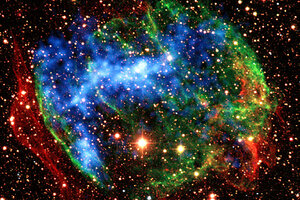What makes a supernova? Scientists thought they knew.
New X-ray research questions the origins of a key type of supernova, and may bend one of astronomy's go-to rulers.

This composite file image of infrared and x-ray images shows the remnants of a supernova.
NASA
One of astronomy's most heavily used tools for measuring distances may be less reliable than researchers have assumed, according to a pair of astrophysicists.
Their conclusion, which will be published in Thursday’s issue of the journal Nature, doesn't appear to cast doubt on decades of discoveries about the structure and evolution of the universe that relied on the tool – a form of exploding star called a Type 1A supernova.
These events "are the most important explosions in cosmology," says Marat Gilfanov, one of the two researchers involved in the Nature study.
In principle the new result "muddies the waters" for such stunning discoveries as the existence of dark energy, says astrophysicist Mario Livio, with the Space Telescope Science Institute in Baltimore.
At the least, the result – if it holds up – represents "an embarrassment for all astrophysicists," he says. "For decades we've been studying these types of explosions, and we still don't know" which of two broad mechanisms are involved in triggering them. That implies that there may be differences in the amount of light they produce, even though they've been lumped into the same class of supernovae, he said during a press briefing Wednesday.
Supernovae briefly outshine the galaxies that contain them. Using observations of nearby supernovae and the types of stars that exploded, astronomers concluded that Type 1A supernovae tended to reach the same intrinsic peak brightness. And they had a telltale signature – their light faded over time in a characteristic pattern different from other types of supernovae.
Because light dims at a predictable rate with distance, researchers use the light from Type 1A supernovae as a kind of standard candle that allows them to calculate the distances to galaxies in which the explosions occur.
But over time, some researchers suggested that the process for generating a Type 1A supernova could vary.
Type 1As are thought to occur in a binary star system in which one member is a white dwarf – an end-of-life phase for a star like the sun – and the other a star still in its prime. Gravity from the white dwarf, which packs our sun's mass into an Earth-sized volume, draws matter from its companion. When the white dwarf's mass exceeds 1.4 times the sun's mass, the dwarf explodes as a supernova.
Yet researchers also have suggested that a merger of two white dwarfs could trigger a Type 1A supernova. One way to tell the difference: Look at their X-ray emissions; the dwarf-on-dwarf merger should display weaker X-ray emissions than an explosion resulting from accretion, when a white dwarf pirates material from a normal companion.
Dr. Gilfanov and Akos Bogdan, with the Max Planck Institute for Astrophysics in Garching, Germany, looked at the X-ray, visible, and infrared emissions from six elliptical galaxies relatively close to the Milky Way. The X-ray data came from NASA's Chandra X-Ray Observatory.
Based on estimates of the number of stellar explosions one would typically expect to find in a galaxy, the X-ray emissions were 30 to 50 times weaker in the galaxies they studied than one would expect if the Type 1A supernovae were triggered by accretion, rather than by mergers.
In complementing the work, Dr. Livios cautions that "the conclusion is weakened by the fact we're talking about a nondetection," likening it to the Sherlock Holmes tale in which the sleuth cracked the case based in large part on a dog that didn't bark.
More work needs to be done, the researchers acknowledge, to see if the same relative dearth of X-rays is present in spiral galaxies, which have far higher rates of star formation – and explosive star deaths – as ellipticals.
However, Livios adds, these results and recent observational evidence that Type 1A supernovae display slightly different light output, depending on the type of galaxy they inhabit, "emphasize the need to really finally try to understand what the progenitor [star] systems really are."
